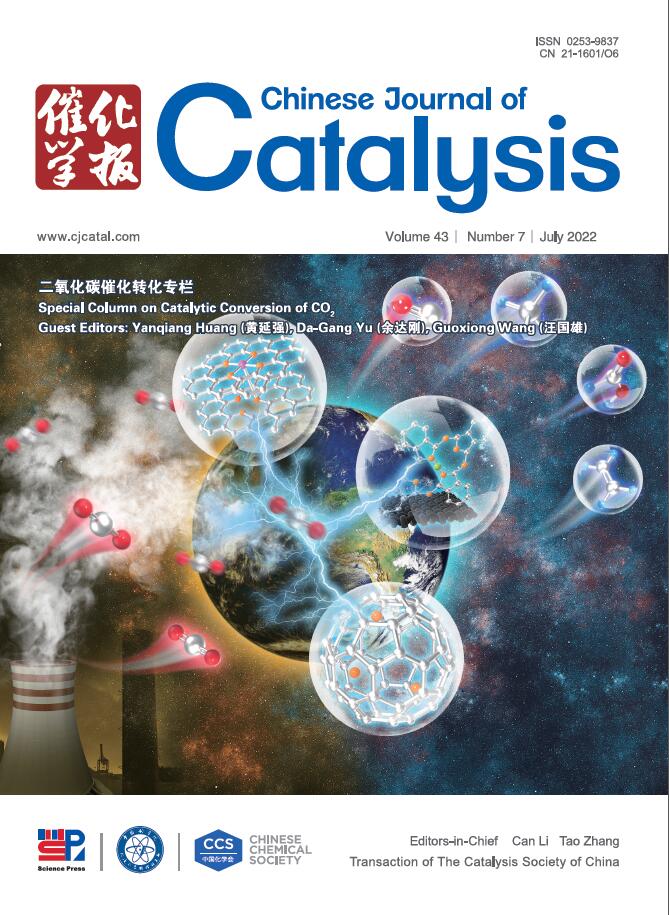设计用于合成气衍生DMO加氢乙醇合成的网状缺陷碳化钼
IF 17.7
1区 化学
Q1 CHEMISTRY, APPLIED
引用次数: 0
摘要
碳化钼在各种加氢反应中显示出巨大的潜力,是草酸二甲酯加氢合成乙醇的主要活性物质,是煤炭资源高效利用的关键步骤。在本研究中,精心设计了具有三维网状中空结构和晶格缺陷的碳化钼催化剂。采用火焰喷雾热解法制备了具有丰富氧空位和缺陷的MoO3前驱体,并采用溅射法引入了结构改性剂Cu。溅射沉积的Cu影响了渗碳和相演化过程。形成由缺陷碳化钼组成的三维网状空心结构,β-Mo2C出现晶格畸变和缺陷。该缺陷β-Mo2C具有较高的反应活性,有利于C=O加氢反应,在草酸二甲酯加氢反应中表现出83.1%的高反应活性。本研究为碳化钼催化剂的设计和应用提供了新的思路。本文章由计算机程序翻译,如有差异,请以英文原文为准。
Designing mesh-like defective molybdenum carbides for ethanol synthesis via syngas-derived DMO hydrogenation
Molybdenum carbide has shown great potential in various hydrogenation reactions, and serves as a primary active species for synthesis of ethanol from dimethyl oxalate hydrogenation process which is a crucial step in the efficient utilization of coal resources. In this study, a molybdenum carbide catalyst with a three-dimensional mesh-like hollow structure and lattice defects was carefully designed. The MoO3 precursor with abundant oxygen vacancies and defects was prepared by flame spray pyrolysis, and a structural modifier, Cu, was introduced by sputtering. The Cu deposited by sputtering affected the carburization and phase evolution processes. A three-dimensional mesh-like hollow structure composed of defective molybdenum carbide is formed, with the β-Mo2C exhibiting lattice distortions and defects. This defective β-Mo2C exhibits high reactivity, and facilitates the C=O hydrogenation process, showing a high reactivity of 83.1% yield in the hydrogenation of dimethyl oxalate. This work provides a new approach to the design and application of molybdenum carbide catalysts.
求助全文
通过发布文献求助,成功后即可免费获取论文全文。
去求助
来源期刊

Chinese Journal of Catalysis
工程技术-工程:化工
CiteScore
25.80
自引率
10.30%
发文量
235
审稿时长
1.2 months
期刊介绍:
The journal covers a broad scope, encompassing new trends in catalysis for applications in energy production, environmental protection, and the preparation of materials, petroleum chemicals, and fine chemicals. It explores the scientific foundation for preparing and activating catalysts of commercial interest, emphasizing representative models.The focus includes spectroscopic methods for structural characterization, especially in situ techniques, as well as new theoretical methods with practical impact in catalysis and catalytic reactions.The journal delves into the relationship between homogeneous and heterogeneous catalysis and includes theoretical studies on the structure and reactivity of catalysts.Additionally, contributions on photocatalysis, biocatalysis, surface science, and catalysis-related chemical kinetics are welcomed.
 求助内容:
求助内容: 应助结果提醒方式:
应助结果提醒方式:


